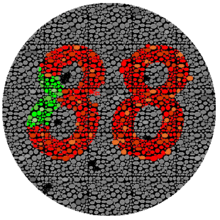38 (number)
38 (thirty-eight) is the natural number following 37 and preceding 39.
| ||||
|---|---|---|---|---|
[[{{#expr: (floor({{{number}}} div {{{factor}}})) * {{{factor}}}+({{{1}}}*{{{factor}}} div 10)}} (number)|{{#switch:{{{1}}}|-1={{#ifexpr:(floor({{{number}}} div 10)) = 0|-1|←}}|10=→|#default={{#expr:(floor({{{number}}} div {{{factor}}})) * {{{factor}}}+({{{1}}}*{{{factor}}} div 10)}}}}]] [[{{#expr: (floor({{{number}}} div {{{factor}}})) * {{{factor}}}+({{{1}}}*{{{factor}}} div 10)}} (number)|{{#switch:{{{1}}}|-1={{#ifexpr:(floor({{{number}}} div 10)) = 0|-1|←}}|10=→|#default={{#expr:(floor({{{number}}} div {{{factor}}})) * {{{factor}}}+({{{1}}}*{{{factor}}} div 10)}}}}]] [[{{#expr: (floor({{{number}}} div {{{factor}}})) * {{{factor}}}+({{{1}}}*{{{factor}}} div 10)}} (number)|{{#switch:{{{1}}}|-1={{#ifexpr:(floor({{{number}}} div 10)) = 0|-1|←}}|10=→|#default={{#expr:(floor({{{number}}} div {{{factor}}})) * {{{factor}}}+({{{1}}}*{{{factor}}} div 10)}}}}]] [[{{#expr: (floor({{{number}}} div {{{factor}}})) * {{{factor}}}+({{{1}}}*{{{factor}}} div 10)}} (number)|{{#switch:{{{1}}}|-1={{#ifexpr:(floor({{{number}}} div 10)) = 0|-1|←}}|10=→|#default={{#expr:(floor({{{number}}} div {{{factor}}})) * {{{factor}}}+({{{1}}}*{{{factor}}} div 10)}}}}]] [[{{#expr: (floor({{{number}}} div {{{factor}}})) * {{{factor}}}+({{{1}}}*{{{factor}}} div 10)}} (number)|{{#switch:{{{1}}}|-1={{#ifexpr:(floor({{{number}}} div 10)) = 0|-1|←}}|10=→|#default={{#expr:(floor({{{number}}} div {{{factor}}})) * {{{factor}}}+({{{1}}}*{{{factor}}} div 10)}}}}]] [[{{#expr: (floor({{{number}}} div {{{factor}}})) * {{{factor}}}+({{{1}}}*{{{factor}}} div 10)}} (number)|{{#switch:{{{1}}}|-1={{#ifexpr:(floor({{{number}}} div 10)) = 0|-1|←}}|10=→|#default={{#expr:(floor({{{number}}} div {{{factor}}})) * {{{factor}}}+({{{1}}}*{{{factor}}} div 10)}}}}]] [[{{#expr: (floor({{{number}}} div {{{factor}}})) * {{{factor}}}+({{{1}}}*{{{factor}}} div 10)}} (number)|{{#switch:{{{1}}}|-1={{#ifexpr:(floor({{{number}}} div 10)) = 0|-1|←}}|10=→|#default={{#expr:(floor({{{number}}} div {{{factor}}})) * {{{factor}}}+({{{1}}}*{{{factor}}} div 10)}}}}]] [[{{#expr: (floor({{{number}}} div {{{factor}}})) * {{{factor}}}+({{{1}}}*{{{factor}}} div 10)}} (number)|{{#switch:{{{1}}}|-1={{#ifexpr:(floor({{{number}}} div 10)) = 0|-1|←}}|10=→|#default={{#expr:(floor({{{number}}} div {{{factor}}})) * {{{factor}}}+({{{1}}}*{{{factor}}} div 10)}}}}]] [[{{#expr: (floor({{{number}}} div {{{factor}}})) * {{{factor}}}+({{{1}}}*{{{factor}}} div 10)}} (number)|{{#switch:{{{1}}}|-1={{#ifexpr:(floor({{{number}}} div 10)) = 0|-1|←}}|10=→|#default={{#expr:(floor({{{number}}} div {{{factor}}})) * {{{factor}}}+({{{1}}}*{{{factor}}} div 10)}}}}]] [[{{#expr: (floor({{{number}}} div {{{factor}}})) * {{{factor}}}+({{{1}}}*{{{factor}}} div 10)}} (number)|{{#switch:{{{1}}}|-1={{#ifexpr:(floor({{{number}}} div 10)) = 0|-1|←}}|10=→|#default={{#expr:(floor({{{number}}} div {{{factor}}})) * {{{factor}}}+({{{1}}}*{{{factor}}} div 10)}}}}]] [[{{#expr: (floor({{{number}}} div {{{factor}}})) * {{{factor}}}+({{{1}}}*{{{factor}}} div 10)}} (number)|{{#switch:{{{1}}}|-1={{#ifexpr:(floor({{{number}}} div 10)) = 0|-1|←}}|10=→|#default={{#expr:(floor({{{number}}} div {{{factor}}})) * {{{factor}}}+({{{1}}}*{{{factor}}} div 10)}}}}]] [[{{#expr: (floor({{{number}}} div {{{factor}}})) * {{{factor}}}+({{{1}}}*{{{factor}}} div 10)}} (number)|{{#switch:{{{1}}}|-1={{#ifexpr:(floor({{{number}}} div 10)) = 0|-1|←}}|10=→|#default={{#expr:(floor({{{number}}} div {{{factor}}})) * {{{factor}}}+({{{1}}}*{{{factor}}} div 10)}}}}]] | ||||
| Cardinal | thirty-eight | |||
| Ordinal | 38th (thirty-eighth) | |||
| Factorization | 2 × 19 | |||
| Divisors | 1, 2, 19, 38 | |||
| Greek numeral | ΛΗ´ | |||
| Roman numeral | XXXVIII | |||
| Binary | 1001102 | |||
| Ternary | 11023 | |||
| Octal | 468 | |||
| Duodecimal | 3212 | |||
| Hexadecimal | 2616 | |||
In mathematics
- 38! − 1 yields 523022617466601111760007224100074291199999999, which is the 16th factorial prime.[1]
- There is no answer to the equation φ(x) = 38, making 38 a nontotient.[2]
- 38 is the sum of the squares of the first three primes.
- 37 and 38 are the first pair of consecutive positive integers not divisible by any of their digits.
- 38 is the largest even number which cannot be written as the sum of two odd composite numbers.
- There are only two normal magic hexagons, order 1 (which is trivial) and order 3. The sum of each row of an order 3 magic hexagon is 38.[3]
In science
- The atomic number of strontium
Astronomy
- The Messier object M38, a magnitude 7.0 open cluster in the constellation Auriga
- The New General Catalogue object NGC 38, a spiral galaxy in the constellation Pisces
In other fields

Most people will see the number 38, but people with red-green color blindness might see 88 instead.
Thirty-eight is also:
- The 38th parallel north is the pre-Korean War boundary between North Korea and South Korea.
- The number of slots on an American roulette wheel (0, 00, and 1 through 36; European roulette does not use the 00 slot and has only 37 slots)
- The number of games that each team in a sports league with 20 teams that plays a full home-and-away schedule (with each team playing the others one time home and one time away) will play in a season. The most notable leagues that currently have a 38-game season are the top divisions of association football in England and Spain, respectively the Premier League and La Liga.
- Bill C-38 legalized same-sex marriage in Canada
- The number of years it took the Israelites to travel from Kadesh Barnea to the Zered valley in Deuteronomy.
- A "38" is often the name for a snub nose .38 caliber revolver
- The 38 class is the most famous class of steam locomotive used in New South Wales
- The number of the French department Isère
- The "over-38 rule" is a feature of the NBA salary cap that affects contracts of players who turn 38 during their deals.
gollark: IRS is Internal Revenue Service.
gollark: RSA is Rotating Stellar Avocados.
gollark: Technically, we *did* make a substantial fraction of pigeons sapient and networked them into a hive mind, slightly.
gollark: Some birds apparently grasp trade with humans, so it's fine.
gollark: BRB, teaching crows to pay taxes.
References
- Sloane, N. J. A. (ed.). "Sequence A002982 (Numbers n such that n! - 1 is prime)". The On-Line Encyclopedia of Integer Sequences. OEIS Foundation. Retrieved 2016-05-31.
- (sequence A005277 in the OEIS)
- Higgins, Peter (2008). Number Story: From Counting to Cryptography. New York: Copernicus. p. 53. ISBN 978-1-84800-000-1.
This article is issued from Wikipedia. The text is licensed under Creative Commons - Attribution - Sharealike. Additional terms may apply for the media files.